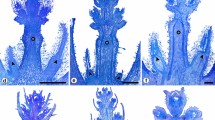Abstract
Previous studies of reproductive structures in the helobial monocotyledons (Alismatidae) indicate that partitioning between flower and inflorescence is not always clear (e.g.,Lilaea,Scheuchzeria) and that this may be the result of ancestral, unisexual modules coming together to form flowers and/or inflorescences. Later evolutionary changes may have included the inflorescence becoming involved or mixed in with vegetative growth. Substitution of vegetative buds for flowers is the simplest version, and there can be additional modifications to the growth behavior of the inflorescence, such as horizontal growth and dorsiventrality. In the Alismataceae and Limnocharitaceae the derivation of stolonlike structures from inflorescences is obvious: vegetative features have been incorporated into structures that are recognizably inflorescences. In the Hydrocharitaceae the interrelationships between the inflorescence and the vegetative body are much less well defined. We previously suggested forHydrocharis, where a single axillary complex can contain both inflorescence and stolons, that the stolon is basically a sterilized inflorescence and that features of the inflorescence have become incorporated into the vegetative body. Here we will explore this theme further for the Hydrocharitaceae, using information from within and outside the family.
Similar content being viewed by others
Literature Cited
Brunaud, A. 1976. Ramification chez les Hydrocharitaceae I—Ontogénie du système des pousses. Rev. Gén. Bot. 83: 397–413.
—. 1977. Ramification chez les Hydrocharitaceae II—Organisation des rameaux latéraux. Rev. Gén. Bot. 84: 137–157.
Bugnon, F. & G. Joffrin. 1962. Recherches sur la ramification de la pousse chez laVallisneria spiralis. Mém. Soc. Bot. France (1962): 61–72.
——. 1963. Ramification de la pousse chez l’Hydrocharismorsus-ranae L.: Comparaison avec le cas duVallisneria spiralis L. Bull. Soc. Bot. France 110: 34–42.
Charlton, W. A. 1973. Studies in the Alismataceae. II. Inflorescences of the Alismataceae. Canad. J. Bot. 51:775–789.
— &A. Ahmed. 1973. Studies in the Alismataceae. IV. Developmental morphology ofRanalisma humile and comparisons with two members of the Butomaceae,Hydrocleis nymphoides andButomus umbellatus. Canad. J. Bot. 51: 899–910.
—,A. D. Macdonald, U. Posluszny &C. P. Wilkins. 1989. Additions to the technique of epiillumination light microscopy for the study of floral and vegetative apices. Canad. J. Bot. 67: 1739–1743.
Johansen, D. A. 1940. Plant Microtechnique. McGraw-Hill, New York.
Kaul, R. B. 1970. Evolution and adaptation of inflorescences in the Hydrocharitaceae. Amer. J. Bot. 57: 708–715.
Les, D. H. &R. R. Haynes. 1995. Systematics of subclass Alismatidae: A synthesis of approaches. Pp. 353–377in P. J. Rudall, P. J. Cribb, D. F. Cutler and C. J. Humphries (eds.), Monocotyledons: Systematics and evolution. Royal Botanic Gardens, Kew.
Miki, S. 1937. The originof Najas andPotamogeton. Bot. Mag. (Tokyo) 51: 472–480.
Posluszny, U. &W. A. Charlton. 1993. Evolution of the helobial flower. Aquatic Bot. 44: 303–324.
——. 1999. Multiple redundancy inHydrocharis morsus-ranae. Pp. 135–146;in M. H. Kurmann and A. R. Hemsley (eds.), The evolution of plant architecture. Royal Botanic Gardens, Kew.
— &P. B. Tomlinson. 1991. Shoot organisation in the seagrassHalophila (Hydrocharitaceae). Canad. J. Bot. 69: 1600–1615.
Rohrbach, P. 1871. Beiträge zur Kenntniss einiger Hydrocharideen. Abh. Naturf. Ges. Halle 12(75): 53–114.
Sculthorpe, C. D. 1967. The biology of aquatic vascular plants. Edward Arnold, London.
Shaffer-Fehre, M.. 1991a. The endotegmen tuberculae. An account of little-known structures from the seed coat of the Hydrocharitoideae (Hydrocharitaceae) and ofNajas (Najadaceae). J. Linn. Soc., Bot. 107: 169–188.
—. 1991b. The position ofNajas within the subclass Alismatidae (Monocotyledones) in the light of new evidence from seed coat structures in the Hydrocharitoideae (Hydrocharitales). J. Linn. Soc., Bot. 107: 189–209.
Wigand, C. &J. C. Stevenson. 1997. Facilitation of phosphate assimilation by aquatic mycorrhizae ofVallisneria americana Michx. Hydrobiologia 342/343: 35–41.
Wilder, G. J. 1974a. Symmetry and development ofButomus umbellatus (Butomaceae) andLimnocharis flava (Limnocharitaceae). Amer. J. Bot. 61: 379–394.
—. 1974b. Symmetry and developmentof Limnobium spongia (Hydrocharitaceae). Amer. J. Bot. 61: 624–642.
—. 1974c. Symmetry and development of pistillateVallisneria americana (Hydrocharitaceae). Amer. J. Bot. 61: 846–866.
—. 1975. Phylogenetic trends in the Alismatidae (Monocotyledoneae). Bot. Gaz. 136: 159–170.
Author information
Authors and Affiliations
Rights and permissions
About this article
Cite this article
Charlton, W.A., Posluszny, U. Morphological traffic between the inflorescence and the vegetative shoot in helobial monocotyledons. Bot. Rev 65, 370–384 (1999). https://doi.org/10.1007/BF02857755
Issue Date:
DOI: https://doi.org/10.1007/BF02857755




